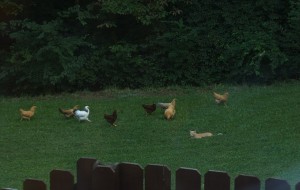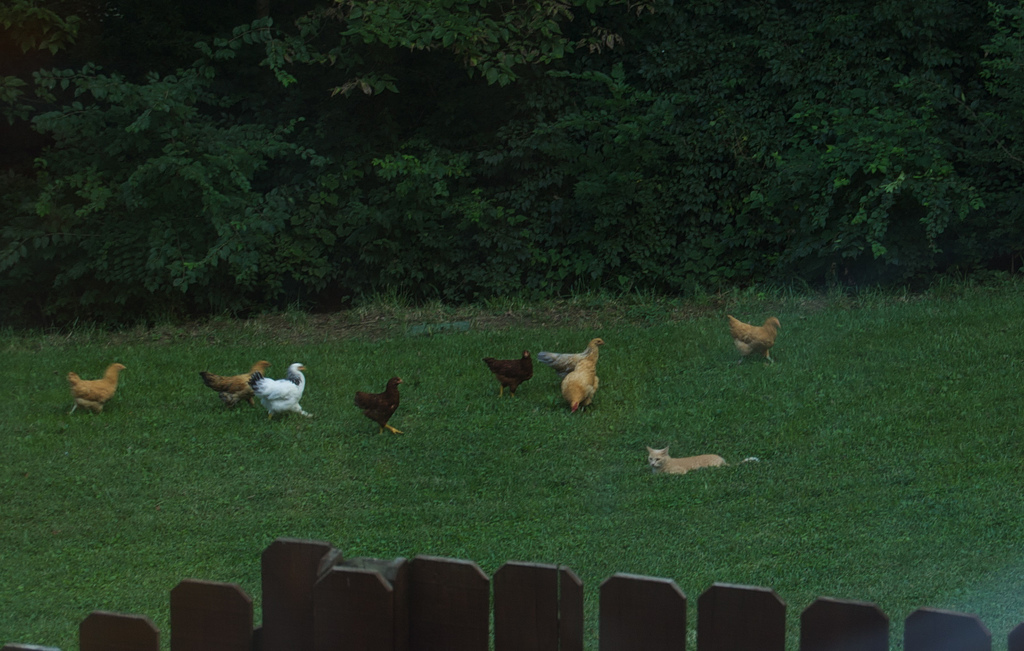
A few weeks ago I went down to the coop to find a 250 watt heat bulb melted through the 5 gallon bucket bottom. The plastic was fused to the heat bulb. I promptly unplugged the two heat lamps and opened the windows to the coop. Luckily, plastic only smolders. Don’t fumigate your livestock. Nix the plastic buckets.
I made a trip to Lowe’s a few days later on a Monday evening. As a cold snap was coming the following day, I had to rig up something, and quickly. So, here is the new supply list:
1 outdoor extension cord with three outlets long enough to go from the outlet to the rafters (run along the walls neatly would be nice, and safer too!)
3 heat lamps with metal heat shields (buy them for $6 each at the farm supply, instead of the $12 at Lowe’s)
3 250 watt red heat lamp bulbs (spring for the name brand here – I use Phillips bulbs for around $9 each)
15 feet of chain (buy it in a pack and ask someone to cut it into pieces long enough to span between 2 rafters – it’s cheaper than getting chain by the foot) $4
6 pack of S hooks (make sure they are large enough to accommodate the links of the chain) $2
So, continuing from the old article, the power is run from the house to the outbuilding. The outlet on the wall is first controlled by a hot water heater thermostat. This you can set to whatever temperature you like – mine is at 45 degrees, but it is less than that as the heat lights have stayed on – the outlet will be turned “off” by the thermostat once the desired temperature is reached, then on again as needed. I had a 15 foot chain cut into 3 5 foot pieces. I ran my outdoor grade extension cable neatly up the wall and wrapped three times around the far rafter. I decided to place my heat lamps about 2.5 feet apart, as the coop is 10 feet wide. Remember, don’t put the heat lamps close to a wall or rafter! These things get hot and will catch anything on fire if in contact! Take one length of chain, and one S hook. Loop the chain over the far rafter and secure the end of the chain to the rest of the chain under the rafter so that the S hook is fully extended. With slack, the chain might fall if bumped by a chicken. Lace the lamp onto the chain through the loop above the porcelain socket. As a precaution, I wrapped the heat lamp cord around the rafter, without leaving slack, and plugged it into the extension cord on the end of the rafter. I did this in case a chicken bumped the chain. The lamp would simply hang by the cord – and the worst that could happen in that situation would be a wire coming off of the contact in the lamp – easy fix. Just make sure when you wrap your cord, you imagine the chain falling – where is your lamp going to fall? Next to a wall? Touching a rafter? A straw bale? Repeat this for all the lamps.
Keeping the coop at 40 – 50 degrees will keep chickens laying through the winter, but remember to turn the lights down to allow them to go into moult. This is important in the chicken life cycle. With heat lights, both the heat and the light created by the lamps alters the laying cycle. I, personally, don’t heat the coop specifically for winter eggs. Chickens’ combs and waddles are susceptible to frost bite. To prevent this, simply rub petroleum jelly on the combs and wattles every few days. I simply don’t see that as a practical, long term solution, so I’d suggest springing for the heat.
Also, if you are handy enough, these bulbs as well as an outside coop light and an automated hen door can be powered by solar energy. Too worried about losing power with solar? Don’t! If the heat lamps go off in the night, as long as the coop is draft free and you leave the doors and windows shut, it should maintain the temperature until the next daylight.
